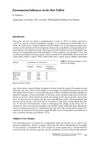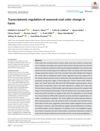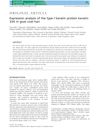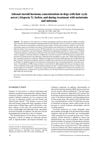TLDR Black-tailed deer have four types of pelages and molt twice a year.
The study on the pelage and molt in black-tailed deer (Odocoileus hemionus) revealed that these deer have four distinct pelages: natal, juvenile, adult summer, and adult winter. The deer molt twice annually, with the spring molt involving only guard hair follicles and the autumn molt involving all follicles. The guard hairs, which serve a sensory function, increase in diameter from birth to adult winter pelage and are longest in the adult summer pelage. The study also found significant differences in the length-diameter relationships of guard hairs among different populations of black-tailed deer. The same follicle is inferred to produce both summer and winter hairs, as well as age-related changes in hair.
22 citations
,
April 1967 in “Australian Journal of Zoology” Southern elephant seals develop hair follicles and skin layers before birth, with moulting starting a week after birth and finishing in three weeks.
 12 citations
,
January 1981 in “Springer eBooks”
12 citations
,
January 1981 in “Springer eBooks” Environmental factors like temperature and nutrition affect hair growth, with humans showing seasonal hair growth differences.
 2 citations
,
August 1995 in “Acta agriculturæ Scandinavica. Section A, Animal science”
2 citations
,
August 1995 in “Acta agriculturæ Scandinavica. Section A, Animal science” Adult male raccoon dogs shed their winter fur in spring and grow new fur for winter in autumn.
 18 citations
,
January 2020 in “Ecology and evolution”
18 citations
,
January 2020 in “Ecology and evolution” Genes related to pigmentation, body rhythms, and behavior change during hares' seasonal coat color transition, with a common genetic mechanism in two hare species.
 8 citations
,
July 2011 in “Animal science journal”
8 citations
,
July 2011 in “Animal science journal” Keratin 33A is a key protein in goat winter coats, especially in high-producing breeds.
 52 citations
,
October 2004 in “Veterinary dermatology”
52 citations
,
October 2004 in “Veterinary dermatology” Melatonin and mitotane treatment led to hair re-growth in 62% of dogs with Alopecia X, but this was not always linked to normal hormone levels.




